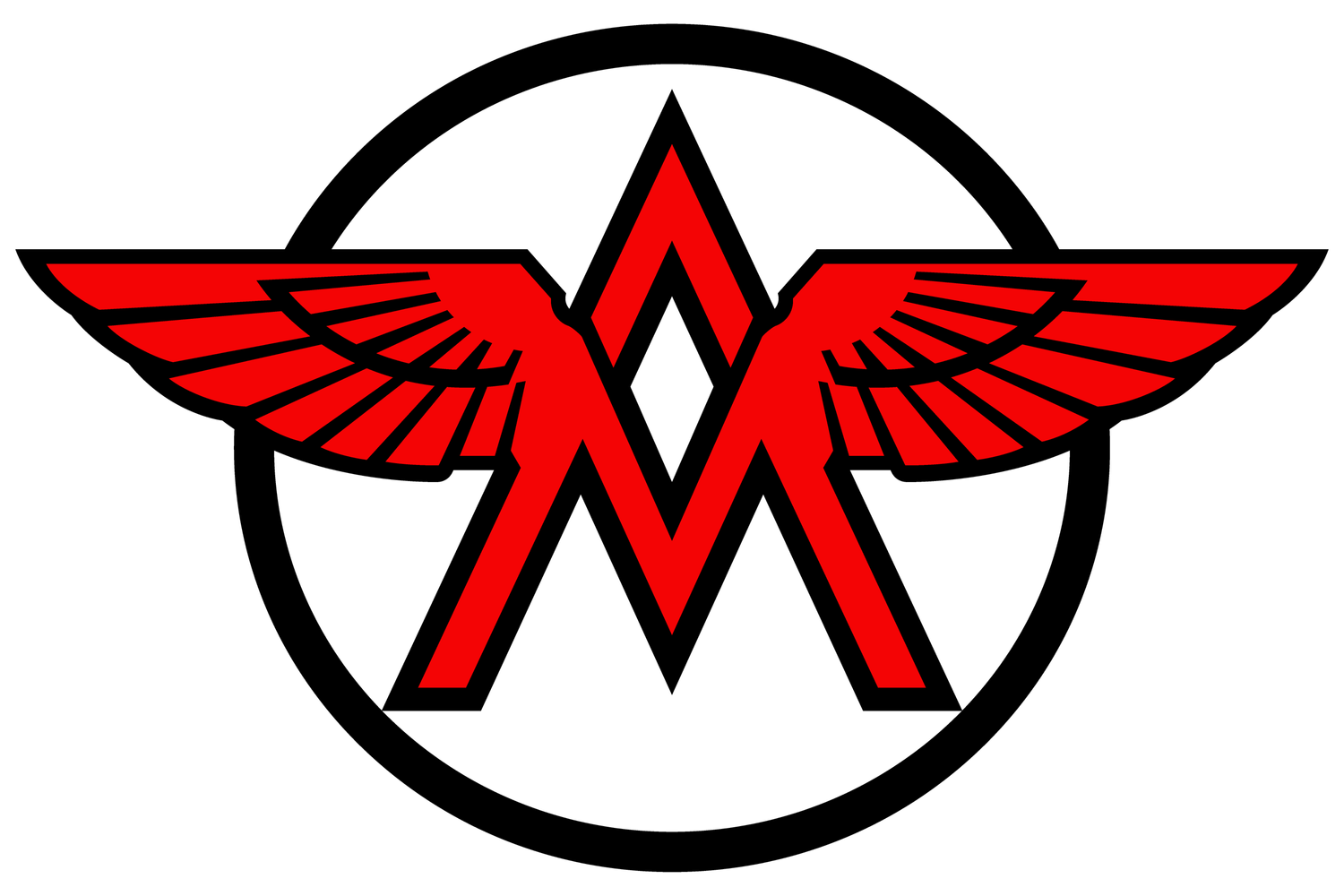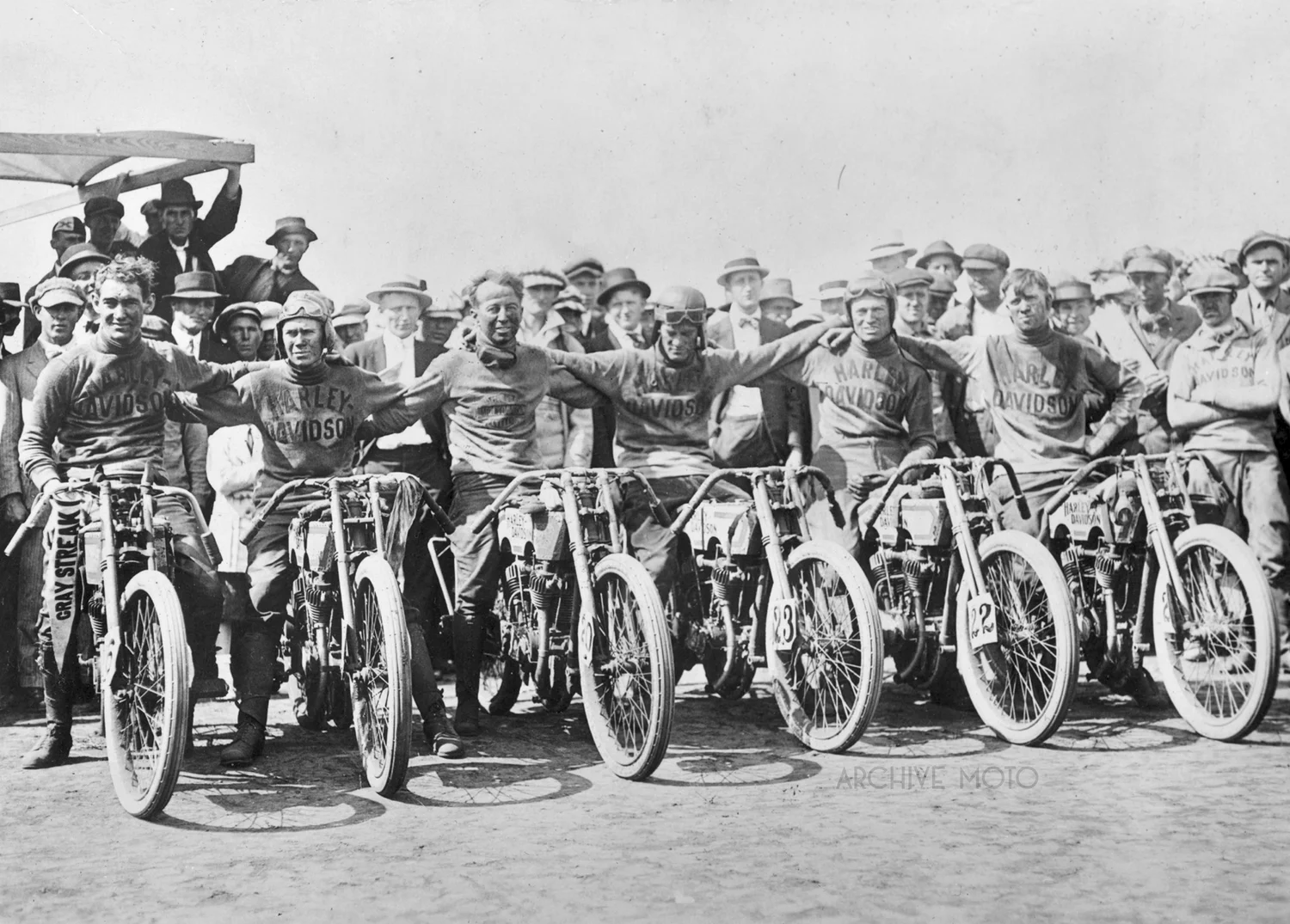Part III: Hedstrom’s Catalysts
It was to Daytona's hallowed granules of sand that Indian’s Oscar Hedstrom again migrated in 1908 with that age old twinkle in his eye and an assortment of high-strung racing prototypes. This legendary image was taken on that trip, and though most would see four men on four “old-timey” motorcycles, the moment captured in this photo is more exceptional once one knows more detail. Though the idea of board track racing immediately comes to mind when anyone sees machines like these, low-slung, bar-bones, skinny-wheeled monster cycles, the machines you see here actually predate the golden era of the motordrome, in fact one could argue that these are the very machines that gave birth to the craze.
Four unique motorcycles, all the brainchildren of Hedstrom, represent a rapid mechanical evolution and experimental design that the mad scientist of Springfield began in 1903. The first of their kind, each machine utilizes a long wheelbase loop-frame, a design which first appeared on a single-rider, belt-driven bicycle pacing machine in early 1907. The roots of these motorcycles however are apparent in what is quite possibly Hedstrom’s first racing purebred, a retooled-DeDion powered racer that he ran at the first Carnival of Speed in 1903. This loop-frame DNA made its crude debut in that early racer which was constructed using components from the last of the three Henshaw-Hedstrom Typhoon tandem pacers. That same 1903 prototype was again reconfigured for the 1904 run at Ormond Beach, now featuring twin DeDion style engines, not twin cylinder but two complete engines mounted in the frame side by side and connected at the crankpin.
Within 6 months of that 1904 run at Ormond Hedstrom unveiled his own twin cylinder prototype power plant in Newport, RI. It was that twin cylinder design that spawned the creation of Indian's first civilian model twin and laid the groundwork for the racing engines fitted into these later racing models. The first appearance of these loop frames came in 1907 when Hedstrom acquired a more powerful French Puegeot-Simplex twin cylinder engine. He most likely purchased the motor through friend William Wray Jr. who began racing for the French company that same year. It was this stout engine from France, a 14 HP beast that Hedstrom constructed a very odd land speed motorcycle, most commonly known as the Hot Shot. Again, a new loop frame design was utilized, but with a completely unique electrical, fuel, and oil tank configuration which more resembled the style of the factory “monkey on a stick” racer. 1907 also marked the first year that Indian took control of their own engine casting and production, a task that the Aurora Machine and Tool Company had been contracted to perform since 1902.
The next iteration of the loop-frame twin debuted in yet another one-off creation of Hedstrom's, this time specifically built for pioneer racer Jake DeRosier. The machine was however not a racer but rather a pacer, or stayer as they are often referred to. It was in fact the earliest Indian to feature a belt-drive and appeared in New Jersey in July of 1908. The prototype single-rider pacing motorcycle featured a new long wheelbase loop frame, twin cylinder engine, long streamlined tank fit between the upper frame rails which took a distinct turn down to allow the seat to be in the lowest center of gravity. DeRosier piloted the pacing machine at various bicycle races at the newly constructed Clifton Stadium Velodrome in Paterson, NJ in 1908, until Hedstrom developed yet another pure bred racing machine for DeRosier to run on that same experimental track.
In August of 1908, Hedstrom introduced his next prototype, another loop frame twin racer, but this one was built for the track. Likely developed at the same time as the belt-drive pacer, this “Bent Tank” twin shared a similar frame and distinctive fuel tank which had a sharp downturned angle under the seat. It was on that “Bent Tank” racer that DeRosier returned to the slightly larger board track Velodrome at Clifton and smashed several standing records, hitting speeds nearly 70 mph. That machine represents a turning point for everyone involved. Hedstrom had arrived at a refined design that would become the standard, dominating machine of a new professional racing industry. Jake DeRosier soon penned a deal with Indian becoming the first of the professional motorcycle riders and went on to defining what it meant to be a racer. Jack Prince, the man responsible for constructing the wooden bicycle tracks around the country witnessed the potential of racing motorcycles on wooden saucers, he then quickly redesigned the short bicycle tracks specifically for motorcycle competition and gave birth to the motordrome craze. The “Bent Tank” racers were then passed around between a multitude of potential up-and coming speedsters like Robert Stubbs, Morty Graves, and Freddie Huyck, each proving their worth on the experimental machine and signing contracts to ride for the newly forming, and soon to be legendary Indian factory team.
As a result, 1909 was a catalyst year in the motorcycle racing industry. By March Jack Prince had designed, constructed, and opened the gates to his first board track Motordrome, the Los Angeles Coliseum, the first track specifically intended for motorcycle races. By mid-summer he would complete America’s first circular wooden motordrome in Springfield. The annual Carnival of Speed held just north of Daytona at Ormond Beach was still a popular event, though attendance was waining from previous years it was still impossible to get a room in the area without sharing it with someone else. The impending completion of the much-buzzed about Indianapolis Speedway was just around the corner, and the Carnival of Speed was seemingly teetering on the edge of obsolescence as a new American industry began to explode. Oscar Hedstrom had boiled down his mechanical recipe for speed to a streamlined factory racer, he also introduced some of the racing technology, like the loop frame design into Indian’s 1909 production lineup. A new factory racer was released and it mirrored many of the features found in its distinctive “Bent Tank” predecessor. A long wheelbase loop frame, 61ci twin cylinder 7HP engine, chain drive, dropped bars, and lengthened torpedo tank painted with block letters all had been passed on from the earlier prototypes. The sharp angled bend in the rear of the tank used in the prototypes was gone however, and the tank now resembled the same design that would be present through Indian’s most lucrative years.
In late March, 1909, Oscar Hedstrom arrived yet again to the World’s birthplace of speed, Ormond Beach with a handful of his most promising factory riders and a train car full of his proven prototype motorcycles. New York’s Walter Goerke, seen here farthest to the left onboard one of Hedstrom’s 1908 “Bent Tank” prototypes set new records for the flying mile, the kilometer, the 5 mile, and smashed the world hour record set at Brooklands. Goerke also lowered the standing record for a mile to 45 1/5 seconds, as set by Glenn Curtiss in Daytona just 2 years before. Birmingham’s Robert Stubbs, seen behind Goerke onboard the new streamlined 1909 Indian factory racer set a new record in the 1 mile time trails, but on the second day at nearly 80 mph Stubbs hit some lose sand which sent him violently tumbling over the bars and demolishing his machine, though he apparently came out of the ordeal unscathed. New York’s A.G. Chapple was a long time friend of Walter Goerke, and was most often his greatest competition. Chapple, seen smiling behind Stubbs also competed on one of Hedstrom 7HP “Bent Tank” twin prototypes, on which he won the 10 mile event in 8 minutes, 57 seconds, as well as hit an average speed of 69mph winning the 20 mile in 17 minutes, 25 1/5 seconds. The veteran of the Speed Carnival, the mad mechanic of Springfield Oscar Hedstrom who was present at the event’s inception stands just beyond the focus in the button-up sweater. He stands proudly with his 14 horsepower Peugeot-Simplex powered Hot Shot, the prototype he developed 3 years prior which paved the way for the purebred machine’s it accompanies. Onboard his beloved Hot Shot Hedstrom went toe to toe with his friend William H. Wray, who had returned to run his 14 HP Simplex, though neither man was able to best Wray’s previous 1 mile time of 44 2/5 seconds.
This photo captures a moment in time perfectly, a moment when the fearless pioneers of a new sport first mounted machines capable of testing their nerve to the absolute limit. Motorcycles had jumped past their humble, cumbersome ancestors and evolved into sleek, modern instruments capable of pure velocity. Within a few short months the sport would change, speed trails had taken the place of endurance and reliability competitions and would soon give way to the death defying mania of the motordrome. An industry had established itself in America, and a new sport was on the rise. Hedstrom and Indian would come to dominate this rapidly approaching golden era, a prophecy that the men and machines in this photograph seem to understand all to well.






